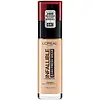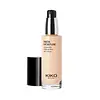What's inside
What's inside
 Key Ingredients
Key Ingredients

 Benefits
Benefits

 Concerns
Concerns

 Ingredients Side-by-side
Ingredients Side-by-side

Ethylhexyl Methoxycinnamate 6.743%
UV AbsorberTitanium Dioxide 3.591%
Cosmetic ColorantWater
Skin ConditioningDimethicone
EmollientIsododecane
EmollientAlcohol Denat.
AntimicrobialButylene Glycol
HumectantTrimethylsiloxysilicate
EmollientPEG-10 Dimethicone
Skin ConditioningPerlite
AbsorbentSynthetic Fluorphlogopite
Nylon-12
Isopropyl Lauroyl Sarcosinate
Skin ConditioningDiisopropyl Sebacate
EmollientDisteardimonium Hectorite
StabilisingHdi/Trimethylol Hexyllactone Crosspolymer
Bis-PEG/PPG-14/14 Dimethicone
EmollientMagnesium Sulfate
Aluminum Hydroxide
EmollientPhenoxyethanol
PreservativeDisodium Stearoyl Glutamate
CleansingHydrogen Dimethicone
Dipentaerythrityl Tetrahydroxystearate/Tetraisostearate
Skin ConditioningParfum
MaskingSilica Silylate
EmollientAcrylonitrile/Methyl Methacrylate/Vinylidene Chloride Copolymer
Tocopherol
AntioxidantHexyl Cinnamal
PerfumingSilica
AbrasiveIsobutane
Benzyl Salicylate
PerfumingLinalool
PerfumingAlpha-Isomethyl Ionone
PerfumingBenzyl Alcohol
PerfumingBHT
AntioxidantCitronellol
PerfumingIron Oxides
CI 77510
Cosmetic ColorantEthylhexyl Methoxycinnamate 6.743%, Titanium Dioxide 3.591%, Water, Dimethicone, Isododecane, Alcohol Denat., Butylene Glycol, Trimethylsiloxysilicate, PEG-10 Dimethicone, Perlite, Synthetic Fluorphlogopite, Nylon-12, Isopropyl Lauroyl Sarcosinate, Diisopropyl Sebacate, Disteardimonium Hectorite, Hdi/Trimethylol Hexyllactone Crosspolymer, Bis-PEG/PPG-14/14 Dimethicone, Magnesium Sulfate, Aluminum Hydroxide, Phenoxyethanol, Disodium Stearoyl Glutamate, Hydrogen Dimethicone, Dipentaerythrityl Tetrahydroxystearate/Tetraisostearate, Parfum, Silica Silylate, Acrylonitrile/Methyl Methacrylate/Vinylidene Chloride Copolymer, Tocopherol, Hexyl Cinnamal, Silica, Isobutane, Benzyl Salicylate, Linalool, Alpha-Isomethyl Ionone, Benzyl Alcohol, BHT, Citronellol, Iron Oxides, CI 77510
Water
Skin ConditioningDimethicone
EmollientIsohexadecane
EmollientEthylhexyl Methoxycinnamate
UV AbsorberPhenyl Trimethicone
Skin ConditioningMica
Cosmetic ColorantPolymethylsilsesquioxane
Caprylyl Dimethicone Ethoxy Glucoside
EmulsifyingTitanium Dioxide
Cosmetic ColorantCocoglycerides
EmollientButylene Glycol
HumectantSorbitan Isostearate
EmulsifyingDimethicone Crosspolymer
Emulsion StabilisingAluminum/Magnesium Hydroxide Stearate
Emulsion StabilisingGlycerin
HumectantPhenoxyethanol
PreservativeSodium Chloride
MaskingCaprylic/Capric Triglyceride
MaskingZinc Stearate
Cosmetic ColorantSilica Silylate
EmollientPotassium Sorbate
PreservativeSodium Dehydroacetate
PreservativeTocopheryl Acetate
AntioxidantDisodium EDTA
Carthamus Tinctorius Seed Oil
MaskingAloe Barbadensis Leaf Extract
EmollientRubus Idaeus Leaf Extract
Skin ConditioningCI 77891
Cosmetic ColorantCI 77491
Cosmetic ColorantWater, Dimethicone, Isohexadecane, Ethylhexyl Methoxycinnamate, Phenyl Trimethicone, Mica, Polymethylsilsesquioxane, Caprylyl Dimethicone Ethoxy Glucoside, Titanium Dioxide, Cocoglycerides, Butylene Glycol, Sorbitan Isostearate, Dimethicone Crosspolymer, Aluminum/Magnesium Hydroxide Stearate, Glycerin, Phenoxyethanol, Sodium Chloride, Caprylic/Capric Triglyceride, Zinc Stearate, Silica Silylate, Potassium Sorbate, Sodium Dehydroacetate, Tocopheryl Acetate, Disodium EDTA, Carthamus Tinctorius Seed Oil, Aloe Barbadensis Leaf Extract, Rubus Idaeus Leaf Extract, CI 77891, CI 77491
Ingredients Explained
These ingredients are found in both products.
Ingredients higher up in an ingredient list are typically present in a larger amount.
Butylene Glycol (or BG) is used within cosmetic products for a few different reasons:
Overall, Butylene Glycol is a safe and well-rounded ingredient that works well with other ingredients.
Though this ingredient works well with most skin types, some people with sensitive skin may experience a reaction such as allergic rashes, closed comedones, or itchiness.
Learn more about Butylene GlycolDimethicone is a type of synthetic silicone created from natural materials such as quartz.
What it does:
Dimethicone comes in different viscosities:
Depending on the viscosity, dimethicone has different properties.
Ingredients lists don't always show which type is used, so we recommend reaching out to the brand if you have questions about the viscosity.
This ingredient is unlikely to cause irritation because it does not get absorbed into skin. However, people with silicone allergies should be careful about using this ingredient.
Note: Dimethicone may contribute to pilling. This is because it is not oil or water soluble, so pilling may occur when layered with products. When mixed with heavy oils in a formula, the outcome is also quite greasy.
Learn more about DimethiconeEthylhexyl Methoxycinnamate is an organic compound that provides UVB protection. It often goes by the more common name of octinoxate. It is created from methoxycinnamic acid and 2-ethylhexanol.
Ethylhexyl Methoxycinnamate absorbs UVB rays with wavelengths between 280-320 nm. UV absorbers protect your skin by using chemical reactions to convert UV rays into heat and energy.
UVB (290-320 nm) rays emit more energy than UVA rays. They are capable of damaging DNA, causing sunburns and are thought to be linked to skin cancer.
The state of Hawaii has banned sunscreens containing octinoxate due to its potential impact on coral reefs. More research is needed to bridge gaps in this research. The European Union allows higher levels of octinoxate in sunscreens than the US and Australia.
Ethylhexyl Methoxycinnamate is oil soluble. It is not stable and may lose efficacy when exposed to sunlight.
Learn more about Ethylhexyl MethoxycinnamatePhenoxyethanol is a preservative that has germicide, antimicrobial, and aromatic properties. Studies show that phenoxyethanol can prevent microbial growth. By itself, it has a scent that is similar to that of a rose.
It's often used in formulations along with Caprylyl Glycol to preserve the shelf life of products.
Silica Silylate is a siloxane polymer, meaning it is made up of silicon and oxygen atoms. It is not soluble in water.
This ingredient is a white powder with oil-absorbing, emollient, and anticaking properties.
Titanium dioxide is a mineral UV filter widely used in sunscreens and cosmetics.
It is one of only two UV filters officially classified as “mineral” by regulatory agencies, the other being zinc oxide.
Titanium dioxide provides broad-spectrum protection mostly in the UVB and UVAII range, with some protection in the UVAI range.
While its UVA protection isn’t as strong as zinc oxide’s, the difference is minor.
A common myth is that mineral UV filters reflect UV light. However, modern research shows titanium dioxide absorbs UV radiation like chemical filters (~95% absorption & 5% reflection).
Thanks to its non-irritating nature, titanium dioxide is suitable for sensitive, acne-prone, or redness-prone skin. It is unlikely to cause "eye sting" like other sunscreen ingredients.
A major drawback of this ingredient is its white cast and thick texture. This is why mineral sunscreens often leave a white cast and are less cosmetically elegant than chemical/hybrid sunscreens.
To improve white cast and spreadability, micronized or nano-sized titanium dioxide is often used.
There are ongoing concerns surrounding nano-titanium oxide's impact on marine ecosystems.
There is no conclusive evidence that any form of titanium oxide (or any other sunscreen ingredients) will cause harm to marine ecosystems or coral reefs. The science is still developing but many consumers are keeping a close eye on this issue.
Please note, many destinations have reef-safety sunscreen rules. For instance, the U.S. Virgin Islands advises all visitors to use non-nano mineral sunscreens.
Nano mineral sunscreens once raised safety concerns about absorption into skin.
Extensive research has shown that they do not penetrate healthy or damaged skin; they remain safely on the surface and the top layer of dead skin (stratum corneum).
You'll likely find titanium dioxide bundled with alumina, silica, or dimethicone. These ingredients help make titanium dioxide highly photostable; this prevents it from interacting with other formula components under UV light.
Learn more about Titanium DioxideWater. It's the most common cosmetic ingredient of all. You'll usually see it at the top of ingredient lists, meaning that it makes up the largest part of the product.
So why is it so popular? Water most often acts as a solvent - this means that it helps dissolve other ingredients into the formulation.
You'll also recognize water as that liquid we all need to stay alive. If you see this, drink a glass of water. Stay hydrated!
Learn more about Water